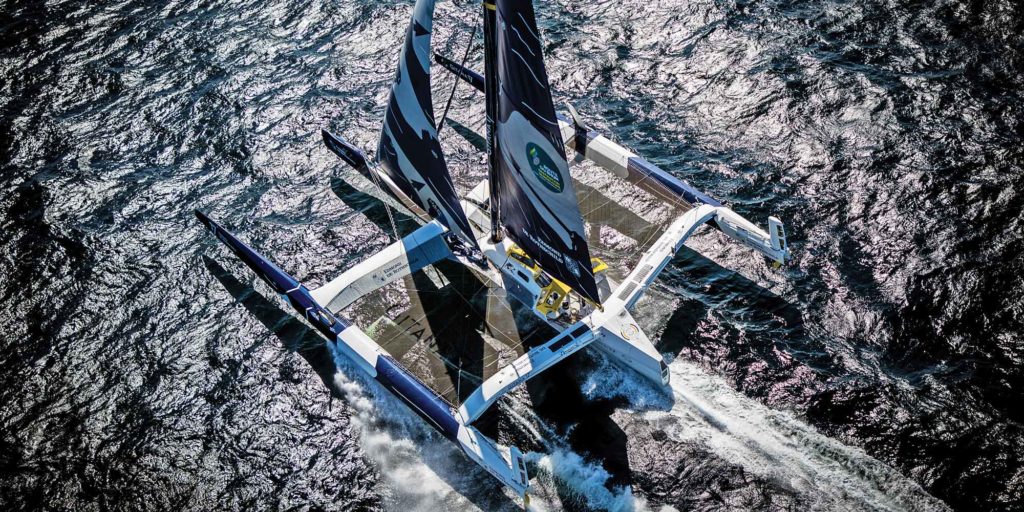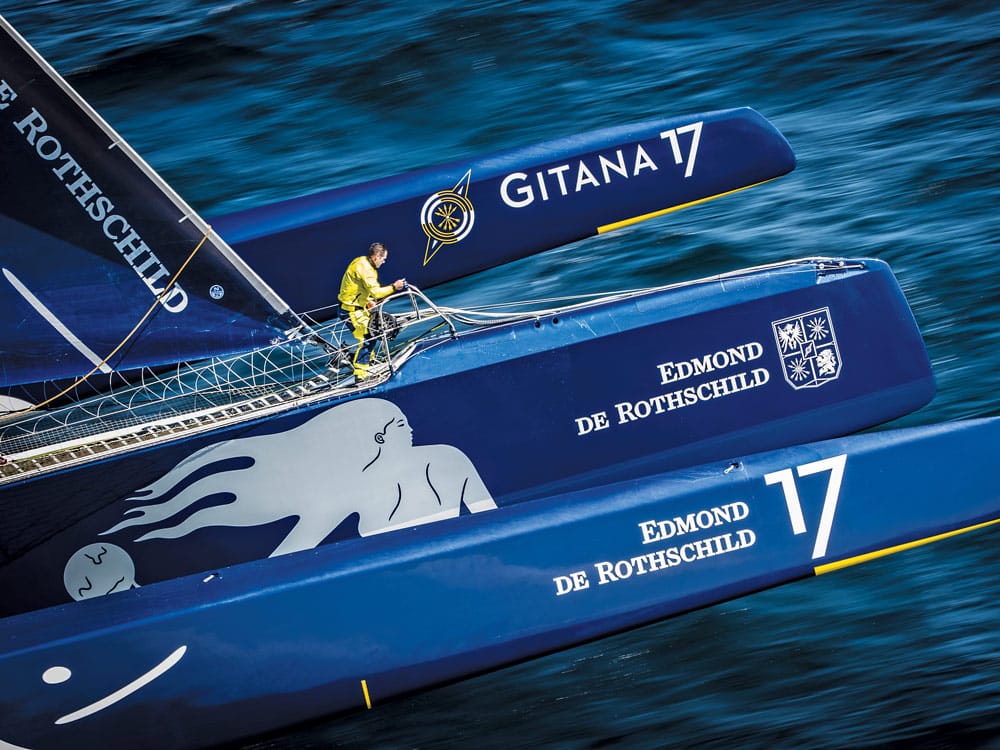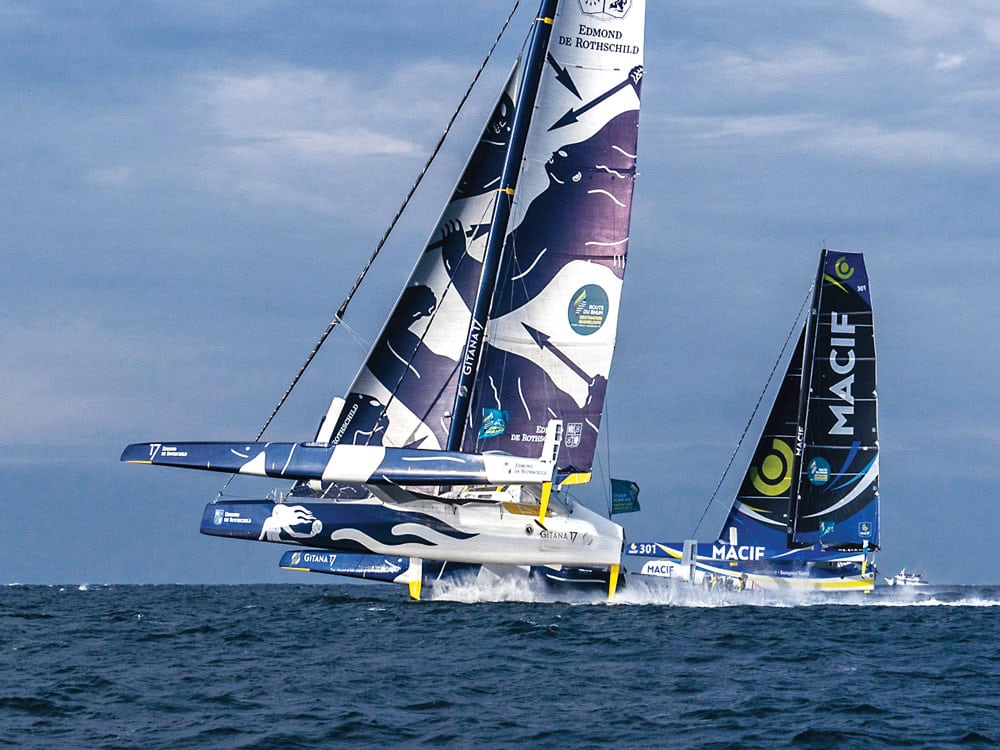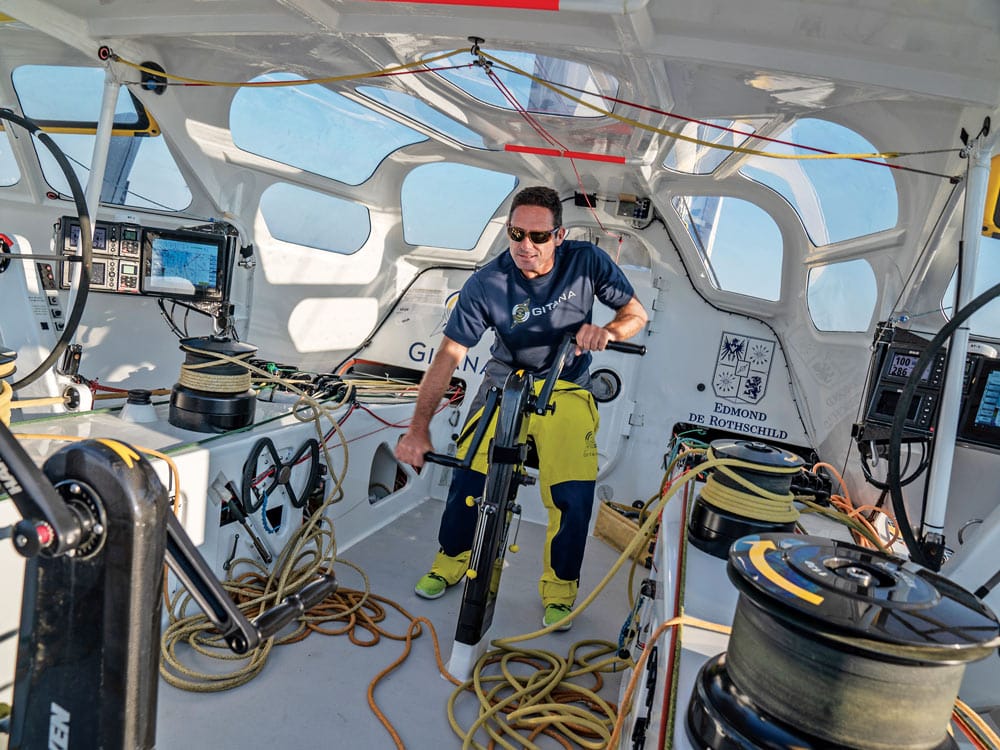
There’s a 60-mile stretch of France’s Brittany coast, between La Trinité-sur-Mer and Port la Forêt, where something in the drinking water causes certain individuals with high concentrations of salt water in their veins to want to go to sea, alone, aboard such monstrous and radical craft. Here, too, French corporations and private individuals, apparently drinking from the same fountain, are willing to bankroll the sailors and their Ultime 100 trimarans, which have already proved capable of 850 singlehanded miles in a day. While it seems likely six new maxi-trimarans, known in France as Ultimes, could be on the Brest Oceans start line, there are at least 10 other such large multihulls in existence, designed for singlehanded round-the-world sailing, that, in theory, could compete in the race as well. Because of severe breakages and one disastrous capsize in the Ultime fleet during the 2018 Route du Rhum, Brest Oceans organizers have good reason to pause and consider the sanity of such a contest of wits and engineering, but the future of high-speed global pursuits is now, and there is no turning back.
Ultimes have the simplest of box rules, parameters intended to create boats that are vaguely similar and capable of racing without escalating costs. Length overall must fall between 24 and 32 meters. Beam must be less than 23 meters and freeboard no less than 1.4 meters. Mast height can be no more than 120 percent of the length of the longest hull. Those that meet Brest Oceans entry requirements include Thomas Coville’s Sodebo Ultim, to be launched in 2019; Francois Gabart’s solo round-the-world and 24-hour record holder MACIF; Seb Josse’s Maxi Edmond de Rothschild; Yves le Blevec’s Actual (nee-Sodebo), which launched in 2014; and, potentially, Armel Le Cléac’h’s maxi Banque Populaire IX, launched in 2017, but which broke and capsized catastrophically in the early stages of the 2018 Route du Rhum Destination Guadeloupe and whose fate, at the time of writing, remains uncertain. One other, belonging to 62-year-old Francis Joyon (winner of the 2018 Route du Rhum), is the present Jules Verne Trophy record holder (fastest nonstop round-the-world fully crewed). Joyon has said he won’t compete in Brest Oceans, but perhaps after his Route du Rhum victory he might change his mind, or his 2006-vintage IDEC Sport will be taken round by someone else.
As an indication of how far multihull sailing technology has evolved in the Ultime class, along with the human ability to sail such craft, consider that it was 14 years ago when Joyon surprised everyone when he managed a solo nonstop lap in 72 days. Since then, other soloists have taken large chunks from the record, especially young Vendee Globe winner Gabart, who, in 2018, shaved a week off Coville’s previous record, reducing the time to just 42 days, 16 hours, 40 minutes and 35 seconds, maintaining an average speed of 27.2 knots.
The evolution of the Ultime shows no sign of slowing either. MACIF was the first to “fly” on foils, but Banque Populaire and Maxi Edmond de Rothschild have been pushed to new limits, capable of foiling in much lower windspeeds. The latter, skippered by Volvo Ocean Race and Vendee Globe skipper Josse, is the latest in an extensive line of multihulls and IMOCA 60s funded by Baron Benjamin de Rothschild, whose boats are also called Gitana. The boat measures in as an Ultime, with a quoted displacement of 15.5 tons, an upwind sail area of 450 square meters and a downwind inventory of 650 square meters.
The VPLP design firm has maintained a monopoly in such large offshore multihulls recently, but Gitana is the first Ultime from the design office of Guillaume Verdier, best known internationally as the naval architect behind Emirates Team New Zealand’s America’s Cup designs. The new maxi trimaran had at least as many people working on it as an America’s Cup campaign (and no doubt a budget to match), which included a mix of experts from Verdier’s design office and Gitana team’s in-house designers in their magnificent purpose-built facility in Lorient, France. They also benefited by considerable input from Emirates Team New Zealand’s technical staff.
Witnessing the Ultimes lined alongside one another in St. Malo, France, before the start of the Route du Rhum, in much the same way as they will be next year in Brest, is a sight to behold. Each has acres of netting filling the spaces between the three hulls. For the size of boat, their raked wing masts look tiny and are stepped as much as two-thirds of the way back from the bow. The reason for such mast placement is balance (Gitana is designed to sail under mainsail alone), but also to counter the multihull’s Achilles’ heel — the propensity to capsize. ORMA 60 trimarans of the past were limited in length, had a beam comparable to their length and were over-canvassed. As a result, they regularly pitch-poled, tripping over the leeward bow. The modern Ultime, however, counters this tendency by having a much longer bow and less beam for the given length. Now, if it capsizes, it does so laterally, or flips as the result of a structural failure, as occurred to Banque Populaire in the Route du Rhum. A secondary advantage of having the sail plan so far aft is that it makes it more headsail-driven. Large furling headsails are easier for the singlehanded sailor to manage than taking a reef in the massive and cumbersome mainsail.

Ultimes have considerable freeboard compared to equivalent-size monohulls. Due to their being capable of sustained speeds of 40 knots and more, and because they are often sailed solo, the cockpits provide critical shelter. In what is effectively a pilothouse, an Ultime skipper can pad around the cockpit, protected from high-pressure saltwater douses and the constant gale of freezing apparent wind. Gitana‘s cabin and cockpit layout are traditional for these boats, with a large covered area of the cockpit and two wheels. Most often, the autopilot will drive the boat, allowing the sailor to access a complex array of hydraulic and sail controls that are located between the wheels. A narrow walkway past the pedestal grinder leads forward to the interior. As is the case with all new Ultimes, the cabin area is on deck for ease of access, the main hull’s interior used only for engines, generators, batteries and stowage.
These boats are already capable of insanely high speeds, and while once upon a time they used to invoke a certain pucker effect when flying the central hull, the latest boats are fitted with foils capable of simply elevating the Ultime’s 13- to 15-ton bulk clear of the water. Because of such high freeboard, the sensation of speed is barely perceivable — even at high boatspeeds. “It is like a four-wheel-drive vehicle,” Verdier says. “Even when you go 40 knots you are not really impressed or scared. That’s one reason you can go so fast.”
Gitana is significantly different from the other Ultimes in that it is a catamaran-trimaran hybrid, i.e., the platform has outboard hulls rather than floats, which are conceptually capable of sustaining greater loads, vital to preventing any movement around its foils. Gitana‘s main hull, although substantial, is now more akin to a beam used to counter fore and aft rig loads and on which to mount a central daggerboard.
The boat also has a unique crossbeam configuration. VPLP’s typical designs, like Banque Populaire, have two sets of beams oriented in an X-type configuration to counter the severe torsional loads these boats experience. Off the rear of the aft beam, a giant semicircular beam of the mainsheet track, the elliptical-shaped space between this and the aft beam form an enclosed area for the cockpit and cabin. Gitana, on the other hand, has two sets of roughly parallel crossbeams, the aft beam forming the aft side (rather than the forward side) of the cockpit, which saves the weight of a dedicated mainsheet track beam.

Trimaran crossbeams usually have complex compound curvature (so they’re high enough to minimize the slamming forces of waves) that then drops down to meet the floats. In comparison, Gitana‘s crossbeams are not like “bits of spaghetti,” Verdier says, but straighter, making them stronger and easier to build. This approach, however, does require the floats to have more freeboard to “meet” the beams. The floats have a U-section shape, so they’re efficient when Gitana isn’t flying. “If you want to make a boat that only foils, then you make it lighter with smaller foils,” says skipper Josse. “But the program of this boat is to sail it singlehanded around the world.”
While recent America’s Cup catamarans have a foil configuration that includes retracting main lifting foils and T-configuration rudders fitted with elevators, the modern Ultimes differ by having a center hull too. Most teams use a third T-rudder on the center hull, as well as a daggerboard, which is fitted with a trim tab to prevent leeway and provide lift when sailing upwind. Consequently, Ultimes perform well in upwind conditions. Gitana‘s daggerboard, in addition to having a trim tab, has an elevator at its base. Verdier says this is not intended to provide downforce, but rather to stabilize the boat.
“On the America’s Cup 50 catamaran you could move the wing very quickly,” Verdier says. “Because it was rigid and self-balanced, it was very easy to sheet in and out, plus you had accurate control of twist. On the Ultimes, it’s very inefficient, very hard to sheet in and out, so there is a big problem with roll stability.” The daggerboard’s elevator supposedly fixes this, making bear-away maneuvers much safer.
The primary foils on Gitana, obviously born from a wealth of America’s Cup experience, differ from Banque Populaire‘s in that when they’re lowered, they have some V-shape to them. The configuration helps make them relatively stable in terms of “heave” (i.e., up-down movement) because, while their rake (fore and aft rotation) can be adjusted, they can’t cant inboard/outboard (lateral rotation) like the foils on America’s Cup catamarans and Banque Populaire do. Cant-angle adjustment allows an L-shaped board (the flatter foil tip shape is faster when conditions allow it to be used) to develop some V. The downside of a cant mechanism, however, is the requirement for heavy hydraulics to operate it.
The significant difference between Ultime and America’s Cup-style foils is their area of operation. AC catamarans are only ever raced inshore in flat water, whereas Ultimes must operate offshore in large waves and confused seas. Consequently, Gitana is fitted with some of the longest foils ever built, Verdier says — around 8 meters long — in order to increase the foil’s draft and thereby allowing the rudder to remain immersed. “It is unknown territory,” he admits. “There is a wave height where you have to stop using the foils. When you are going upwind into 4-meter waves, for example, you should not be foiling anymore.”
RELATED: Francois Gabart Sets New Round-the-World Record
Yet, the boards must still be strong enough to support the entire weight of the boat plus dynamic loadings of around 20 tons. On Gitana, rudders are fitted with elevators to adjust the boat’s fore and aft trim. Rudders can be raised vertically in casings (rather than flip-up) like daggerboards, and have large cowlings above the deck to reduce windage around the top of the boards when hoisted. Josse says he raises the rudders to eliminate drag as well as to prevent them from hitting anything at 40 knots.
As with hull flying on nonfoiling multihulls, Josse says he doesn’t notice the moment his boat becomes airborne. There is no sudden lurch forward as it takes off. “You don’t notice you’re flying — it’s really smooth,” he says. “People expect it to be like a turbo jet, but it isn’t. It is a big boat, and when I do 35 knots it doesn’t feel fast. I have to point out to people they are doing 40 knots.”

Liftoff windspeed, he adds, is currently as low as 15 knots of wind. The art of sailing such giant boats singlehanded requires acknowledging that one will be far from 100 percent efficient. Josse knows the moments where he can push his craft to its limits are rare. Fifteen knots and flat water make it relatively easy. “I’m not good enough to foil all of the time,” he admits. “I do what I know and no more. But just doing that, I’m already at 35 knots. I push when I feel confident in my stability.” The most difficult maneuvers on board are anything involving the boat’s biggest J-0 headsail. “Unfurling it, sheeting it on and furling the J2 takes about 40 to 50 minutes,” Josse says. A tack or jibe takes around 20 minutes (it is not just the laborious process of sheeting in, but all the appendages and their rake settings must be swapped and repeated too, as well as the mast canted to weather on the new tack.
A perpetual niggling worry at high speed is, of course, a capsize. Gitana has manual sheet releases for the headsail and mainsail (Josse sleeps clutching them), but there are also electronic programmable release systems for mainsheet, traveler and jib sheet, should the boat near its tipping point.
As a team, Gitana has been campaigning to increase automation that can be used on Ultimes. At present, an autopilot can steer the boat, but automatic stabilization features are banned. The ban, the team argues, makes the boats less safe and also increases the chance of equipment damage due to operator error. With automation controlling the foils, Josse says, “we would be able to sail in big waves and to fly all the time. At present, we aren’t allowed to do that.”
He considers operating the foils manually, as they must do now, far too slow. “We have three appendages — two rudders and the daggerboard,” Josse says. “To maintain good balance, we should trim them together rather than one by one.”
On Gitana, the peak speed to date is 45 knots in 22 knots of wind, but top speeds are not as important as the daily run. Josse is confident Gabart’s 24-hour solo record can be beaten, and the 1,000-mile day will be a reality within the next five years. But it won’t be easy.
“To be fast in this boat you need flat water, and 20 knots is optimum, and you need 1,000 miles of that,” Josse says. “In 30 knots, the sea state starts to get bad and your stability starts to go down — and then you’re slow.”









